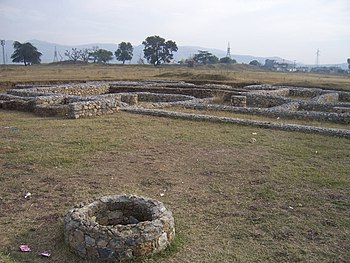Bhir Mound
Bhir Mound ( Urdu : بھڑ ماونڈ) is the oldest of the ruins of Taxila in the Pakistani province of Punjab .
Excavations
The ruins of Bhir Mound were excavated by Sir John Marshall from 1913 to 1925 . His work was supported by Sir Mortimer Wheeler from 1944 to 1945 and by Dr. Mohammad Sharif continued from 1966 to 1967. Further excavations were carried out in 1998-2000 by Bahadur Khan and in 2002 by Dr. Ashraf and Mahmud-al-Hassan.
The ruins
The ruins form an irregular shape that extends about 1 km in north-south direction and about 600 meters in east-west direction. The oldest layer of these ruins is from the sixth and fifth centuries BC. The second layer is from the fourth century and was inhabited during the invasion of Alexander the great . The third layer dates from the time of the Maurya kings of India (third century BC). The fourth and top layer contains structures from the period after the Maurya dynasty.
The streets of the stand are narrow and the houses are built irregularly. There are few other indications for urban planning either. The houses have no windows on the outside. The rooms opened onto an interior courtyard. The courtyards were open and large with 15 to 20 adjoining rooms.
The ruins have been on the UNESCO World Heritage List of the UN since 1980 as part of Taxila.
history
It is widely believed that Darius I was born in 518 BC. BC Bhir Mound conquered. But this claim is based only on textual mentions. In 326 Alexander the Great came to India and conquered this area. It has been reported that Raja Ambhi received the Greek king here. He surrendered to Alexander's armies and supported him with a troop of soldiers with elephants. 316 BC Chandragupta of Magadha, the founder of the Maurya dynasty, conquered the Punjab . Taxila lost its independence and became a provincial capital. The city remained important as a center of administration, education and trade. During the time of Chandragupta's grandson, Ashoka , Buddhism grew in importance and the first Buddhist monks settled here. Ashoka himself is also said to have resided here as his father's vice-king. In 184 BC BC the Greeks of Bactria again conquered the Gandhara and the Punjab region. According to this, a Greek king, Demetrius, resided in Taxila.
Web links
Individual evidence
- ^ Muhammad Ilyas Bhatti: Taxila an ancient metropolis of Gandhara 2006, p. 72.
- ↑ Anke Kausch: Seidenstrasse 2001, p. 300.
- ↑ Muhammad Ilyas Bhatti: Taxila an ancient metropolis of Gandhara 2006, p. 73.
- ↑ UNESCO World Heritage List . Retrieved December 21, 2008.
- ^ Livius.org . Retrieved December 26, 2008.
- ↑ Anke Kausch: Seidenstrasse 2001, p. 300.
Coordinates: 33 ° 44 ′ 36 " N , 72 ° 49 ′ 17" E


